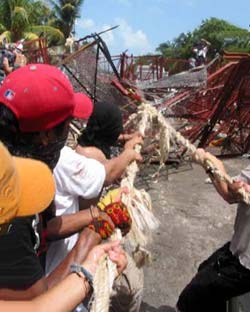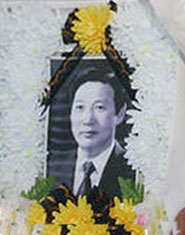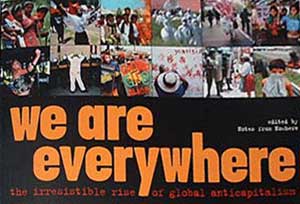|
from 28 september 2003 blue vol II, #98 |
|
|
The Fence at Kilometre Zero 
from Caravan99
 Yesterday [10th September, 2003] in Cancún after hanging a sign that read 'WTO kills farmers' on
the security fence keeping ten thousand protesters from reaching the
Convention Centre. Climbing up to the top of it and facing the direction of
the WTO he cried out, drew out a Swiss Army Knife and stabbing himself in
the heart, fell backwards into the arms of the crowd.
Mr. Lee, who was 56 years old with a wife and two children, had spent a
lifetime campaigning for farmer's rights. He suffered increasingly as the
situation of farmers 10 per cent of the South Korean population had
worsened. "What would your emotional reaction be if your salary was suddenly
cut in half, without you knowing the reason?" Lee had written during his
March vigil. As elsewhere in the world, overproduction and cheap imports
after Korean agriculture was liberalized resulted in massive price drops.
He described abandoned, decaying villages of rural Korea: "Some farmers just
gave up farming and migrated to the urban slums. Others became bankrupted
through debt. Some fortunate people continued but not for much longer, I
suspect. As for me, I could do nothing but look around their vacant and
crumbling houses. I would check them, sometimes, hoping that they had come
back. Once I ran to a house where a farmer had abandoned his life by
drinking toxic chemicals because of his uncontrollable debts. I could do
nothing but listen to the screams of his wife. If you were me, how would you
feel?"
Later, the Korean group described the wave of suicides that had gone through
the farming community, and that Lee had said before he died that he did it
because the WTO was killing farmers around the world. None had anticipated
that Lee would take his own life, and the group were shocked and grieving.
He was rushed to the General Hospital where he died three hours later from
puncture wounds to the heart and lungs.
Dusk fell over the vigil held by the Korean activist delegation outside the
Hospital. Silently, indigenous peasant women from Chiapas wearing their
bright red, pink, blue and orange dresses joined them, carrying candles with
quiet dignity.
Yesterday [10th September, 2003] in Cancún after hanging a sign that read 'WTO kills farmers' on
the security fence keeping ten thousand protesters from reaching the
Convention Centre. Climbing up to the top of it and facing the direction of
the WTO he cried out, drew out a Swiss Army Knife and stabbing himself in
the heart, fell backwards into the arms of the crowd.
Mr. Lee, who was 56 years old with a wife and two children, had spent a
lifetime campaigning for farmer's rights. He suffered increasingly as the
situation of farmers 10 per cent of the South Korean population had
worsened. "What would your emotional reaction be if your salary was suddenly
cut in half, without you knowing the reason?" Lee had written during his
March vigil. As elsewhere in the world, overproduction and cheap imports
after Korean agriculture was liberalized resulted in massive price drops.
He described abandoned, decaying villages of rural Korea: "Some farmers just
gave up farming and migrated to the urban slums. Others became bankrupted
through debt. Some fortunate people continued but not for much longer, I
suspect. As for me, I could do nothing but look around their vacant and
crumbling houses. I would check them, sometimes, hoping that they had come
back. Once I ran to a house where a farmer had abandoned his life by
drinking toxic chemicals because of his uncontrollable debts. I could do
nothing but listen to the screams of his wife. If you were me, how would you
feel?"
Later, the Korean group described the wave of suicides that had gone through
the farming community, and that Lee had said before he died that he did it
because the WTO was killing farmers around the world. None had anticipated
that Lee would take his own life, and the group were shocked and grieving.
He was rushed to the General Hospital where he died three hours later from
puncture wounds to the heart and lungs.
Dusk fell over the vigil held by the Korean activist delegation outside the
Hospital. Silently, indigenous peasant women from Chiapas wearing their
bright red, pink, blue and orange dresses joined them, carrying candles with
quiet dignity.
No-one had expected the day to end this way. It had begun with the Farmer and Indigenous Forum's Declaration at the Via Campesina encampment. This global alliance of small and family farmers, peasants, landless and indigenous people, women and rural labourers, has a combined membership of over 100 million - the vast majority from poor countries. In a stadium filled with campesinos wearing their trademark green t-shirts and caps they called for food sovereignty, a ban on genetically modified foods, and for food and agricultural issues be removed from the remit of the WTO. From their point of view, food is a human right, not a commodity, and its production is fundamental to all human existence. This does not mean that they are 'anti-trade' but that a country needs to support its own food needs and production first. The gathering swelled until it numbered almost 10,000. Peasant women wearing white dresses decorated with bright floral patterns had brought the village to the city: dried fish were strung on lines between trees; cobs of smoked maize were piled in sacks. Tiny children wore green headscarves. A gang of kids wore dolphins made out of foam as hats in protest at the WTO ruling in favour of a Mexican trade complaint against rules on dolphin-friendly tuna fishing. The dolphins and the fishworkers unions uniting on the march was Cancún's answer to Seattle's teamsters and turtles, when unionists and environmentalists came together on the streets. An indigenous movement from the state of Oaxaca, CIPO-RFM, arrived with intricate, intensely coloured murals of their farms painted on sheets. Mexican indigenous call themselves "people of maize" and were the originators of corn as a crop. CIPO-RFM explained: "our ancient varieties are being destroyed by GM corn coming in from the US, cheaper than we can produce." Last year university researchers discovered that between 20 and 60 per cent of traditional maize varieties of crops in CIPO-RFM's community are contaminated with modified genes from imported US corn, and for which Monsanto owns the patent. As one Mexican farmer said, "the protest would have been ten times bigger if our farmers could have afforded to come to Cancún." Those who could not lend their presence lent their support from afar. Recorded messages from the Zapatistas Comandancia rang around the encampment. Comandante David of the EZLN said, "the land is ours, it belongs to the peasants and the indigenous peoples, and we should take it back and make it produce for all, not just for a handful of the wealthy who wouldn't even recognize the colour of the soil if you placed it before them." Zapatista spokesperson Subcomandante Marcos said: "This is not the first time nor the last that those who think they own the planet have to hide behind their high walls and pathetic security forces to make their plans. Just as in any war, the high command of this army of the transnationals, which seeks to conquer the world in the only way that it can be conquered - by destroying it - meets under a security system which is matched in size only by their fear." Joined by Seattle's marching band the Infernal Noise Brigade, students from Mexico City, assorted anarchists and activists banging oil drums lodged in stolen Wal-Mart carts, the march headed towards that high wall protecting the luxury hotel zone. One group carried a puppet of Mayan God Kaluka, a feathered dragon invoked against the WTO's intellectual property rights regime. Another wheeled Chac, a stunning 12 foot high Mayan God, his arms raised towards the heavens, invoked against the privatization of water. Most spectacular of all were the 200 members of KOPA, a coalition of 40 South Korean social movements who walked, banged traditional drums, and sang together. Their procession was a mock Korean-style funeral march for the WTO, replete with multicoloured coffin carried on the shoulders of six and followed by people dressed as priests. We arrived at the heavily policed security fence blocking access to the causeway leading towards the Convention Centre. Some tied banners to it, and others scaled it. With the Koreans in the lead, the crowd began to push sections of the fence over. Then Koreans set fire to the coffin and threw it at the barrier. This was the moment when Lee fell from the fence at the time the nature of his injury was not clear to the crowd, and he was quickly taken away in an ambulance. Then as the Infernal Noise Brigade's drums beat a driving rhythm, the crowd lifted up the fence bodily and toppled it. The heat was intense and people began to suffer from heatstroke. From out of nowhere, a dark grey cloud opened up right over our heads and showered the protesters with cooling rain. John Ross, veteran chronicler of the Zapatista rebellion emerged out of the crowd, grinned with broken teeth and shamanic stare, yelled 'It's Chac the God of Rain!' and dissolved once more into the crowd. A group of boys at the front, reluctant to push through the line of riot police, began to throw stones and sticks instead. The campesinos drew back, some of them hit by stones later blamed on provocateurs that had apparently been thrown from too far back to have been intended for police. The crowd, now fatally divided in tactics, began to lose momentum. Several hours passed in this manner. And then the news spread from person to person, that the Korean man was dying. And this was how the protest ended. The Koreans sat facing a line of riot police who had filled the space where the fence had been torn down, singing a song from the Guangzhou massacre of 1980 which recalled the faces of the dead looking back at those still struggling. Giant letters spelling out 'NO WTO' in golden corn lay at the police's feet. Above them the gaudy banner welcoming trade delegates to Cancún had been half pulled down, revealing a sophisticated culture jam: behind it on the billboard was a picture of the real Cancún impoverished litter pickers combing the beach. The intersection where Lee died is known as Kilometre Zero. Today the Koreans returned to camp there until the WTO stops the meeting out of respect, and called for the Korean delegation to pull out of the meeting immediately. Via Campesina announced: "We do not want any more deaths. We do not want people to die of hunger. We do not want our land to die! At great cost we understand this sacrifice of life, this immolation committed by our friend Lee Kyung Hae has left us speechless and heartbroken. We do not want this death to be in vain; we want a solution to the despair in which a large number of farmers are living because of these international treaties." Though both the official Korean trade delegation and WTO Director General Supachai Panitchpakdi expressed sadness at Lee's death, there is no sign that the demands will be met. KOPA remain steadfast: "He didn't kill himself. The WTO killed him," they said. 
|
|||
